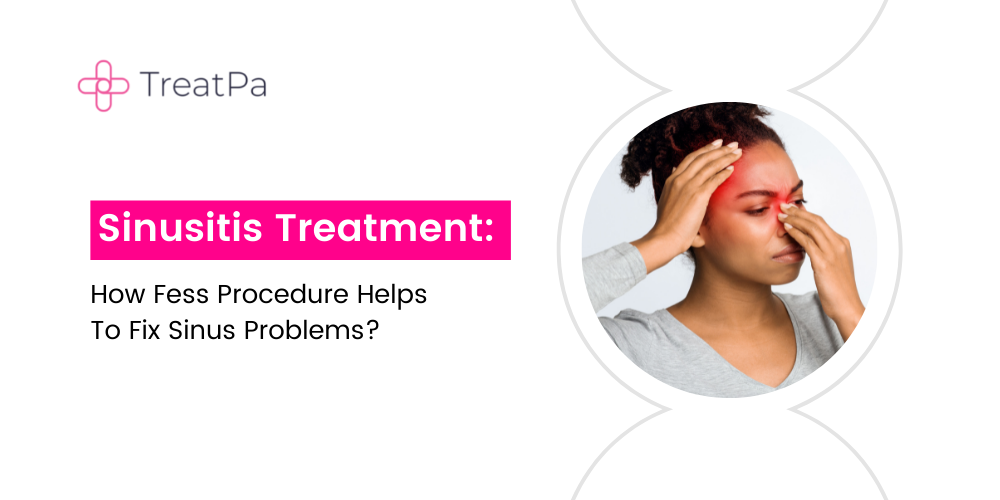Sinus is hollow cavities situated within the frontal area around the nose and eyes. They contribute to the lighter feeling of the skull. Apart from this, these cavities are responsible for mucous secretion to line the nasal passage and keep them moist. The mucus keeps the nose away from foreign particles and germs like bacteria and viruses. The sinus is lined with small-hair-like structures called cilia which help the mucus to pass through the nasal passages.
Usually, these sinuses are filled with air, when they are blocked, fluid fills in and infections can grow. It is more common in adults as the sinus in children is underdeveloped. There are various reasons for a sinus blockage:
- Common cold.
- Nasal Polyps grow in the nasal lining.
- Allergic rhinitis
- Deviated septum
There are various types of sinusitis depending on the duration and blockage.
Acute Sinusitis: This is the least complicated type and also persists for the shortest duration. This sinusitis lasts for around 1 to 2 weeks or maybe up to 4 weeks. Seasonal allergies may also be responsible for acute sinusitis.
Subacute Sinusitis: This type of sinusitis lasts for around 3 months and is caused mainly due to bacterial infections and seasonal allergies.
Chronic Sinusitis: This type lasts for more than 3 months, yet most of the time is considered less severe. Bacterial infections are the main cause of chronic sinusitis. They are a persistent and recurrent kind of infection.
There is also dry sinusitis. This condition is caused when the sinuses do not produce enough mucus. This leads to dryness of the mouth and nose. It causes irritation and inflammation of the sinuses. Symptoms of dry sinus include headache, sore throat, sinus pain, and nosebleed. Rhinosinusitis is also an infection associated with sinusitis.
Symptoms of sinusitis:
Distinguishing between sinusitis and the common cold can be a little tricky as both resemble the same. Symptoms of sinusitis usually involve pressure in the nasal passages, tenderness or puffiness on the face, cloudy nasal discharge, bad breath, fatigue, fever, pain in the ears, and stuffiness of the nose. Sinusitis is usually not contagious. In case it is due to a virus infection it transmits from one person to another. In the case of sinusitis due to bacteria, it is not contagious.
When to see a doctor:
Analyzing your sinus pattern is important. Persistent fever and pressure in the sinus area for about a week requires a visit to the doctor. Doctors may conduct a physical examination for bad breath, greenish mucus, tenderness on the face, and swelling of the nasal passages. If the condition is diagnosed as less severe you have prescribed antibiotics for easing the swelling and controlling the infection.
Why do you need Sinus Surgery?
In most cases, sinus treatment is through medications and home remedies, only in severe cases surgeries are recommended. Chronic sinusitis type is more prone to surgeries as they are more persistent and appear every year. Surgeries involve opening or enlargement of the sinus to make more space for the air to pass without any blockages. In rare cases, the surgeries help in the removal of infected tissue or bone and polyps if present. Modern techniques have relatively reduced surgical bleeding and quick recovery.
Types of sinus surgery:
- Image-guided surgery.
- Functional endoscopic surgery (FESS)
Functional Endoscopic Surgery (FESS): This is the most common type of surgery for the sinus. This is a minimally invasive procedure, where incisions are small and the recovery rate is quick compared to other traditional methods. This is suitable for people who face recurrent acute or chronic sinusitis. Fibrotic telescopes are involved in the diagnosis and also through the surgery procedure. Local anesthesia is involved in this procedure, and people may experience mild discomfort during the process. Computed tomography is involved to identify the diseased areas.
In traditional methods, large incisions were made by giving general anesthesia and the enlargement of the sinus was performed. This procedure involves great risk and recovery time is also comparatively high.
In this new conventional method, at the end of the surgery, the Hydrodebrider™ System may be used to flush out the toxins and bacteria. Once you are done with the surgery a temporary nasal packing is placed to absorb the excess fluid that flows out. The traditional nasal packaging requires a doctor to remove it whereas a modern nasal packaging gets reabsorbed into the body over time. Doctors may require you to follow a few precautions before the surgery. Endoscopic sinus surgery costs depend on various factors like condition, the hospitals, and the severity.
Complications after the surgery are rare in sinusitis surgery. Few may experience headaches and fever after the procedure. Ensure to follow the doctors’ instructions to avoid any serious complications.
This way functional endoscopic surgery is a less complicated surgery. You need not stay at the hospital after surgery and you will be recovered in no time.
Home remedies play a major role in calming the condition as most people are cured using them. Regular steam, Acupressure, warm cloth compression, and nasal sprays are the common home remedies used to control the sinus. Few people may also try nasal irrigation for sinusitis.
Sinusitis is a less complicated condition. In cases of chronic sinusitis when left untreated can become complicated and turn into an abscess of the wall and creating a chronic infection, meningitis, and orbital cellulitis. Prevention is always better than cure. If you are already diagnosed with sinusitis avoid any allergens around you. During the season ensure to continue the home remedies frequently to keep yourself away from infections. Visit an ENT doctor immediately in case of any discomfort.





